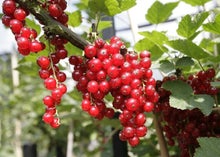
Quick facts
Usually trained as an open-centred bush on a short stem
If space is tight, train as a cordon or fan against a support
Standard-trained gooseberries also take up little space
Prune bushes in late winter
Summer prune cordons and fans
For fewer but larger and easy-to-pick fruits, spur prune bushes in summer
Removing overcrowded branches helps to reduce powdery mildew
Before you start
While gooseberries will still fruit without training and pruning, these prickly plants can quickly become tangled and congested, with branches trailing on the ground. This overcrowding makes harvesting difficult and may encourage problems such as mildew.
Pruning regularly produces a neater, more upright plant with well-spaced growth that is less susceptible to pests and diseases, and fruit that is easier to harvest. Just be aware that gooseberries are prickly shrubs, so protect yourself with thorn-proof gloves when pruning.
The most popular and fruitful training option is a multi-stemmed, open-centred bush, with eight to ten main branches radiating from a short stem (leg). Established bushes can be pruned in two ways – winter branch-renewal pruning every year or two, or spur pruning in winter and summer for a smaller crop of larger fruit.
Where space is limited or to make the most of an east- or north-facing wall or fence, consider growing gooseberries as single- or multi-stemmed cordons. The fruit is produced on short side-shoots growing from the vertical stem(s). Another compact option is a fan, trainedagainst a wall or fence.
Standard-trained gooseberries also take up little space and make an attractive feature in borders, kitchen gardens and formal parterres, or planted in containers.
Fruiting
The flower form at the base of the shoots that grew the previous year and on spurs (short shoots) on older wood. The self-fertile, inconspicuous flowers open in spring.
The fruits hang down from the spiny branches, with ruby-berried cultivars looking particularly attractive. The branches remain productive for a number of years.
What to buy
To grow as a bush, buy a one- or two-year-old plant with a short 10–15m (4–6in) stem and three or more side-shoots. These are widely available container-grown, or can be bought as plants from online suppliers between autumn and spring.
For training, buy a one-year-old cutting or pre-trained cordon from specialist fruit suppliers. It’s also possible to convert a one- or two-year-old bush-trained plant – select one strong, upright shoot and prune the rest back to 2.5cm (1in).
Standards are grafted or budded plants with a single clear ‘trunk’ 1–1.2m (3½–4ft) tall, topped with a bushy ‘head’ of branches. They are generally only available pre-trained from specialist suppliers. To keep the shape, the branches need to be pruned in the same way as bush-trained plants.
To train a fan, buy a one-year-old cutting or a plant sold for cordon training. Prune after planting, cutting the main stem down to 15–20cm (6–8in) from the ground. You may also be able to convert a bush-trained plant – select two to four suitably positioned shoots that can be trained flat against a support and reduce their height by half to encourage further branching. Remove the other shoots. For further advice see our guide to fan training.
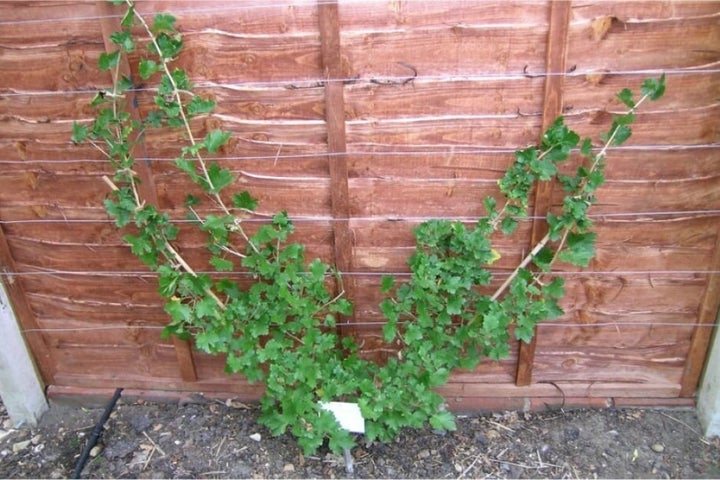
For more on growing gooseberries, see our guide:
When to prune
- From late winter to early spring – prune all trained forms annually, while the plants are still , before any signs of growth appear
- In mid-summer – prune cordons and fans to restrict growth and maintain their shape. You can also spur prune bush-trained gooseberries in summer, in the same way as cordons
Bushes – initial pruning and training
The aim of initial pruning is to create an open-centred, goblet-shaped bush with eight to ten main branches radiating from the short stem (leg). When pruning, make your cuts above an outward-facing , unless the branch is growing at a wide angle close to horizontal, in which case prune above an upward-facing bud.
If planting more than one bush, space them 1.2–1.5m (4–5ft) apart.
Year 1 – pruning after planting
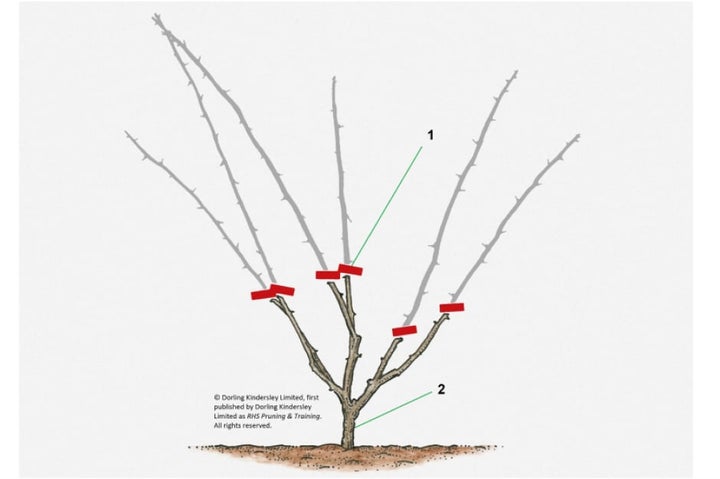
- Select up to five well-spaced, strong shoots and prune them back by a half to three-quarters. Prune out any other shoots
- Remove any shoots growing from the short stem to keep it clear
Year 2 – late winter
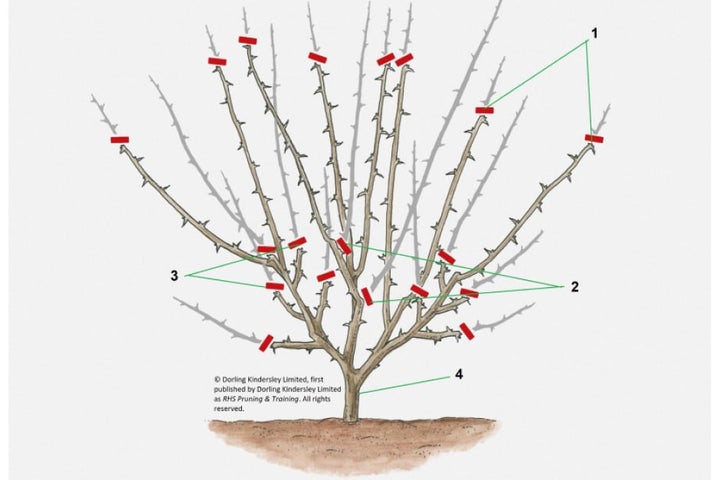
Continue to build up the framework of main branches, aiming for eight to ten in total, in a goblet shape with an open centre.
- Select at least eight strong, outward-growing shoots that will form the main branches, keeping the centre of the bush open. Shorten the selected shoots by up to a quarter
- Remove any strong surplus or badly positioned shoots (for example that are crossing or growing inwards to the centre)
- Prune back the remaining shoots to three or four
- Keep the short main stem clear
Bushes – pruning and training established plants
Branch renewal pruning – winter
Regularly removing a few older, less fruitful branches encourages new replacement shoots to grow, as well as reducing overcrowding and keeping the centre open. Better air circulation through the bush reduces disease problems and extra light helps to ripen the fruit.
Gooseberries have flexible, drooping branches that easily bend under the weight of the fruit. To prevent berries on the lower branches ending up on or near the ground, getting splashed with soil or eaten by rodents, it’s best to remove the low branches or prune them to an upward-facing or side-shoot.

Start by removing any dead or damaged shoots, then:
- On mature bushes, either every year or every other year, remove one to three older, less productive branches to stimulate the growth of strong replacement shoots. Alternatively, prune back to an existing strong side-shoot that can become a replacement. Aim to keep the centre of the bush open
- Remove any shoots growing from the short main stem and any low-growing branches that are likely to touch the ground once laden with berries
Vigorous cultivars may produce a lot of growth on the end of the main branches or on some of the side-shoots. In that case, reduce the previous season’s excessive growth by a quarter to a half.
Spur pruning – winter
To get larger but fewer fruits that are easier to pick from these thorny bushes, spur prune the side-shoots along the main branches. The aim is to develop clusters of short branches that will carry the fruit.

- Prune back last year’s growth on the main branches to three or four
- Cut back last year’s growth on the side-shoots growing from the main branches or on previously pruned side-shoots to two buds
- Keep the short main stem clear
Spur pruning – summer
In mid-June to July, shorten the current season’s growth of side-shoots growing from the main branches, cutting back to five leaves. But avoid pruning any shoots that will be needed to replace old, less fruitful branches.
Standards – pruning and training
A ‘standard’ is a form of training that produces a lollipop-shaped plant, with a tall bare trunk and a ‘head’ of branches at the top.
The branches needs to be pruned in the same way as a bush (see above), to form an open-centred goblet shape. Regular pruning is essential to prevent the head becoming too large and overcrowded. Standards also need a permanent strong stake to support the main stem.
To form the ‘standard’ shape, the fruiting has been grafted (or budded) onto the top of the main stem, which is a different plant, usually Ribes aureum. This means that any shoots (or suckers) growing from the lower part won’t be the desired cultivar. So promptly remove any shoots that sprout from the base or the main stem below the graft point.
Cordons – pruning and training
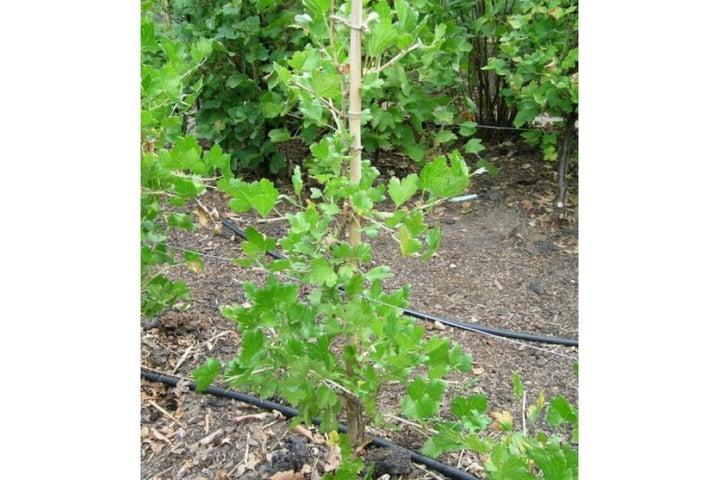
A is a compact form, with one or more stems trained vertically, tied to a permanent support.
If you’ll be growing several plants, it’s best to set up a system of horizontal wires stretched between posts or fixed to a wall or fence. Space the wires 40–60cm (16–24in) apart. Then insert a 1.7m (5ft 6in) bamboo vertically to support each cordon stem, and secure it to the wires. Space single-stemmed gooseberry cordons 30–38cm (12–15in) apart, using the wider spacing on good soil.
If you’re only growing a few plants, strong stakes should be sufficient support.
Cordon gooseberries should be pruned and trained in the same way as redcurrant cordons, see our pruning guide below.


